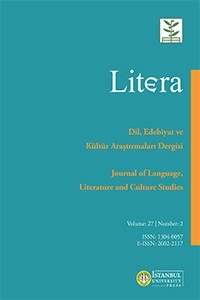Wilkie Collins’in Aytaşı Adlı Romanında Anlatının Sınır Çizgileri ve Uzamsal Yazınbilim
Bu çalışma, postkolonyal anlatıbilim çerçevesinde, Wilkie Collins’in romanında varolan anlatıbilimsel yönleri ve araçları, temsil edilme konusuna odaklanarak keşfetmeyi amaçlamaktadır. Postkolonyal anlatıbilim, anlatısal inceleme kapsamında dikkatini periferal ve ötekileştirilmiş olana yönelterek anlatının iç ve dış sınırlarını sorgular. Bu bağlamda, bu çalışmada odak merkezinde yer alan karakterlerin temsil edilmesi ile, çoklu anlatıcılar veya temsilci seslerin yanısıra zımni yazarın ve yazarsal okuyucunun işlevleri hakkında bazı görüşlere yer verilecektir. Aytaşı’nda çoklu-yerelliğe yer verilmesi, sömürgeci/sömürgeleşmiş arasındaki ilişkileri temel alan marjinalleşme konusunu öne çıkarmaktadır. Romanda, uzamsal yazınbilim doğrultusunda yerlerin çokluğuna rağmen, anlatı söylemi bunların bir kısmına öncelik vererek diğerlerini dış sınırlara yerleştirmektedir. Anlatıda uzam kavramı, hikayenin arka planını oluşturan yer unsuru gibi pasif, durağan ya da hilesiz olmaktan ziyade aktif, akışkan ve bir amaca yöneliktir. Anlatının zamansal-uzamsal yönlerinin yanısıra, karakterlerin anlatıbilimsel sunumları da temsil konusu ve güç dinamikleri açısından son derece önemli bir rol oynamaktadır. Benzer şekilde, açıkça görülmektedir ki, yanlızca mekan ve karakterlerin betimlemesi değil, aynı zamanda çoklu anlatıcılar ile yazarsal okuyucuların yerleşimi de Aytaşı’ndaki emperyal ideolojilerin işlenmesine ortak katkı sağlamaktadır. Anlatıcılar, zımni yazarın tasarısı kapsamında, yaptıkları anlatım işinde tutarlı veya tarafsız olmaktan ziyade kusurlu ve ideolojik olarak konumlanmışlardır. Romandaki tüm bu anlatıbilimsel göstergeler anlatının daima söylemsel bir iş olduğunun kanıtıdır.
Anahtar Kelimeler:
Multitopicality, narratology, spatial poetics, unreliable narrator, Wilkie Collins
Peripheries of Narration and Spatial Poetics in Wilkie Collins’s The Moonstone
This study explores narratological aspects and tools that are employed in WilkieCollins’s The Moonstone within the framework of a postcolonial narratology. Postcolonialnarratology directs its attention to the representation of the peripheral and themarginalized within the scope of narratorial investigation. There will be someconsiderations regarding the representation of focal and voiceless characters, thefunction of the implied author, authorial audience as well as multiple narrators orrepresenting voices. The deployment of multitopicality in The Moonstone brings forththe issue of marginalization predicated on colonizer/colonized relationships. Spatialpoetics in the novel functions in a way in which despite the myriad of settings thatconstitute the story, narrative discourse privileges some places while putting theothers into the peripheries. The concept of space in the narrative proves to be active,fluid and purposeful rather than being passive, static or innocent as in the status ofa background setting. Alongside temporal-spatial aspects, narratological presentationof the characters also plays a fundamental role in relation to power dynamics andthe issue of representation. In the same vein, it is manifest that not only the descriptionof space and characters but also the placement of multiple narrators and authorialaudience concurrently contribute to the treatment of imperial ideologies. As part ofthe implied author’s scheme, the narrators’ act of narration is flawed and ideologicallyloaded rather than consistent or neutral. All these narratological clues in the novelattest to the idea that narration is always a discursive act.
Keywords:
Multitopicality, narratology, spatial poetics, unreliable narrator, Wilkie Collins,
___
- Abbott, H. P. (2008). The Cambridge Introduction to Narrative. Cambridge: Cambridge University Press. google scholar
- Bal, M. (1997). Narratology: Introduction to the Theory of Narrative. Buffalo, London, Toronto: University of Toronto Press. google scholar
- Collins, W. (1982). The Moonstone. London, New York, Sydney, Toronto: Bantam Books. google scholar
- Cozzi, A. (2010). The Discourses of Food in Nineteen-Century British Fiction. Houndmills, Balingstoke, Hampshire: Palgrave Macmillan. google scholar
- Defoe, D. (1994). Robinson Crusoe. London: Penguin Books. google scholar
- Fludernik, M. (2008). Identity/Alterity. In D. Herman (Ed.), The Cambridge Companion to Narrative (pp.260-273). Cambridge: Cambridge University Press. google scholar
- Friedman, S. S. (2005). Spatial Poetics and Arundhati Roy’s A God of Small Things. In J. Phelan & P. Rabinowitz (Eds.), A Companion to Narrative Theory (pp. 192-205). Oxford: Blackwell. google scholar
- GoGwilt, C. (2000). The Fiction of Geopolitics: Aftermarriages of Culture, from Wilkie Collins to Alfred Hitchcock. Stanford: Stanford University Press. google scholar
- Hughes, W. (2005). The Sensation Novel. In P. Brantlinger & W. B. Thesing (Eds.), A Companion to The Victorian Novel (pp. 260-278). London: Wiley-Blackwell. google scholar
- Levine, G. (2008). How to Read Victorian Novel. Malden, Oxford: Blackwell Publishing. google scholar
- Phelan, J. (2007). Estranging Unreliability, Bonding Unreliability and the Ethics of Lolita. Narrative, 15(2), 222-38. 10.1353/NAR.2007.0012. google scholar
- Prince, G. (2005). On a Postcolonial Narratology. In J. Phelan & P. Rabinowitz (Eds.), A Companion to Narrative Theory (pp. 372-381). London: Wiley-Blackwell. google scholar
- Rimmon-Kenan, S. (1983). Narrative Fiction: Contemporary Poetics. London, New York: Routledge. google scholar
- Said, E. (1994). Narrative and Social Space. In Culture and Imperialism (pp. 62-80). New York: Vintage. google scholar
- Schmitt, C. (2005). ‘The Sun and Moon were made to give them light’: Empire in the Victorian Novel. In F. google scholar
- O’Gorman (Ed.), A Concise Companion to the Victorian Novel (pp. 4-24). Malden, Oxford: Blackwell Publishing. google scholar
- Smajic, S. (2010). Ghost-Seers, Detectives, and Spiritualists: Theories of Vision in Victorian Literature and Science. Cambridge, New York: Cambridge University Press. google scholar
- Wall, K. (1994). The Remains of the Day and Its Challenges to Theories of Unreliable Narration. Journal of Narrative Technique, 24, 18- 42. google scholar
- Wisnicki, A. S. (2007). Conspiracy, Revolution, and Terrorism from Victorian Fiction to the Modern Novel. London, New York: Routledge. google scholar
- Başlangıç: 1954
- Yayıncı: İstanbul Üniversitesi
Sayıdaki Diğer Makaleler
“Paracelsus’un Gülü” Öyküsünün İmgelem Kuramı Açısından Yorumlanması
Whatever Singularity in de Bernières’ Captain Corelli’s Mandolin
Commensality and Togetherness in Becky Chambers’ The Long Way to a Small, Angry Planet
Aiding and Abetting Survival: Americanizing Robinson Crusoe through Adaptation
A Criticism of the British Left in Trevor Griffiths’s The Party in Light of ’68 Paris Student Riots
The Landscape of Middle English Focusing on the Adverb Even
Peter Shaffer’s Equus and Equine-assisted Psychotherapy (EAP)
Fethiye KABATAŞ KESKİN, Ebru YENER GÖKŞENLİ
Kurgusal Eserlerde Otizm Ve Buzdolabı Anne Teorisi: Pauline Holdstock’ın Here I Am! Adlı Romanı
